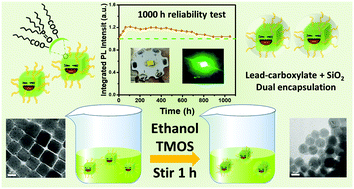Ultra-stable CsPbBr3 nanocrystals with lead-carboxylate/SiO2 encapsulation for LED applications†
Abstract
Perovskite nanocrystals (PNCs) are promising luminescent materials but suffer severe stability issues due to their ionic surface nature. SiO2 encapsulation is widely adopted for stabilizing PNCs in LED lighting and display applications. However, PNCs commonly lose ligands during the SiO2 encapsulation process, leading to fluorescence quenching and agglomeration. Here, CsPbBr3 PNCs with lead-carboxylate capping motif, which shows extraordinary ethanol and moisture resistance, were developed to facilitate fast and controlled growth of PNC–SiO2 nanocrystals using ethanol to accelerate the hydrolysis of tetramethoxysilane. Surface analysis revealed the preservation of the original carboxylate ligands after the reaction. Carboxylate and SiO2 form uniform dual-encapsulation that provides PNCs with superior air and water resistance, excellent photoluminescence maintenance, and high miscibility in silicone resin. Finally, saturated green LED and white-light LED with a wide color gamut were fabricated through on-chip packaging of the PNC–SiO2 on the blue LED chip. LEDs retained >85% of their light intensity after continuous illumination for 1000 h, demonstrating the high potential of the encapsulation method and the materials in light-emitting applications.

- This article is part of the themed collection: Journal of Materials Chemistry C HOT Papers


 Please wait while we load your content...
Please wait while we load your content...